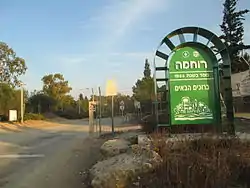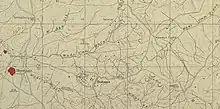Ruhama
Ruhama (Hebrew: רֻחָמָה, "Mercy") is a kibbutz in the Negev desert in southern Israel. The original settlement, established in 1911, is considered the first modern Jewish settlement in the Negev.[2] Located around ten kilometres east of Sderot and surrounded by a nature reserve, it falls under the jurisdiction of the Sha'ar HaNegev Regional Council. In 2019 it had a population of 689.[1]
Ruhama
רֻחָמָה روحامة | |
|---|---|
 | |
 Ruhama  Ruhama | |
| Coordinates: 31°29′48″N 34°42′20″E | |
| Country | Israel |
| District | Southern |
| Council | Sha'ar HaNegev |
| Affiliation | Kibbutz Movement |
| Founded | 1911 (original settlement) 1944 (modern settlement) |
| Founded by | Hashomer Hatzair members |
| Population (2019) | 689[1] |
| Name meaning | 'Mercy' |
History
Ruhama was first established in 1911, on land purchased in the same year by the "Remnant of Israel" (Hebrew: שארית ישראל) company, set up by Russian Jews in Moscow, under the leadership of Simon Velikovsky, the father of Immanuel Velikovsky,[3] to invest money in Jewish agricultural settlements in the Land of Israel. The name derives from the verse: "And I will have mercy upon her that had not obtained mercy" (Hosea 2:23)".[4][5] "An artesian well was dug in 1912, and a rather plentiful supply of water was found at a depth of fifty meters."[3] The group also included members of the socialist Zionist movement Hashomer Hatzair. However, the initial settlers were expelled by the Ottoman Empire in 1917; a dilapidated museum building is all that is left of that original settlement.[2]
However, the artesian well prompted the Allied forces under General Allenby to select Ruhama as their headquarters from which base "the British Army and the Jewish-American Legion conquered Palestine".[3]
HaShomer used the Ruhama farm as its main forward base along the Gaza-Beersheva line.[6]
Two subsequent attempts to re-establish the settlement during the period of the British Mandate were curtailed by the Arab riots in 1929 and 1936. The kibbutz was eventually successfully re-established in 1944, and grew to a population of 399.
Ruhama uses land from the depopulated Palestinian village of al-Jammama.[7]
The film Sweet Mud (2006) was filmed in Ruhama and Nir Eliyahu.[8]
In 2006, a group of the older, diehard communist ideologues blocked an attempt by the younger, more liberal members of Ruhama to establish a synagogue.[9] Later on, in 2012 a synagogue was established in Ruhama to commemorate the name of a boy who was killed by a missiles attack near Gaza.
Images
 Kibbutz Ruhama 1948
Kibbutz Ruhama 1948 View of Ruhama from the airfield, August 1948
View of Ruhama from the airfield, August 1948 Ruhama airfield. August 1948. Operation Avak
Ruhama airfield. August 1948. Operation Avak Yiftach Brigade Headquarters, Kibbutz Ruhama, 1948
Yiftach Brigade Headquarters, Kibbutz Ruhama, 1948 Kibbutz Ruhama, 1948
Kibbutz Ruhama, 1948 Ruhama 1945 1:250,000
Ruhama 1945 1:250,000 Ruhama 1947 1:20,000
Ruhama 1947 1:20,000
Economy
The economy is based on four agricultural branches: field crops, irrigated cultivation, orchards and henhouses, but agricultural crops do not generate enough income to support the kibbutz, so to earn a living, many of Ruhama's members have taken jobs outside the kibbutz.
Like many kibbutzim, Ruhama went through a process of privatization in the late 1990s.
The kibbutz operated a factory which produced brushes, including toothbrushes, which is closed by July 2019. The new owner of the brush business is a trade company who uses the name Kibbutz Ruhama, but closes down the factory.
In 1984, Ruhama established a PCB design company.
Ruhama has a full-care center for elderly patients, with about 25 beds, attending to patients suffering from Alzheimer's disease, Parkinson's disease, dementia, paralysis and stroke. With membership dropping from 350 members to 210, upkeep of the senior care center has meant self-taxation and general belt tightening on the kibbutz.
A symbol of how greatly times have changed, the kibbutz cut community services like the dining room, so that every family now cares for itself.
Attractions
Atar HaRishonim (אתר הראשונים,"Site of the First"), located just outside the fence surrounding the kibbutz, is where the first Jewish settlers in modern times settled in the Negev. The site includes several buildings and a well, as well as farming tools used almost 100 years ago.
Prominent Residents
- Avi Toledano, a popular Israeli singer, lived in Ruhama.
- Recha Frier, a deputy to Zionist leader Henrietta Szold, first lived on a kibbutz near the Lebanese border, but moved to Ruhama in 1947.
- Jonathan Roshfeld from MasterChef Israel
References
- "Population in the Localities 2019" (XLS). Israel Central Bureau of Statistics. Retrieved 16 August 2020.
- Kna'ani, Eliyahu (1981). Ruhama, the first Jewish settlement in the Negev (in Hebrew). Yad Ben Zvi. Retrieved 2007-09-18.
- Velikovsky, Immanuel (1946) The Story of Ruhama New York Times, 19 September 1946
- Place Names in Israel. A Compendium of Place Names in Israel compiled from various sources. Translated from Hebrew, Jerusalem 1962 (Israel Prime Minister’s Office. The Israeli Program for Scientific Translations) p. 167 (Location of the book: Ben Zvi Institute Library, 12 Abarbanel St., Jerusalem; in the online-catalogue:
- Carta's Official Guide to Israel and Complete Gazetteer to all Sites in the Holy Land. (3rd edition 1993) Jerusalem, Carta, p. 403, ISBN 965-220-186-3 (English)
- Goldstein, Yaacov N. and Jacob (1998). From Fighters to Soldiers: How the Israeli Defense Forces Began. Sussex Academic Press, Israel. p. 68. ISBN 1-902210-01-8.
- Khalidi, W. (1992). All That Remains: The Palestinian Villages Occupied and Depopulated by Israel in 1948. Washington D.C.: Institute for Palestine Studies. p. 74. ISBN 0-88728-224-5.
- Sweet Mud sheds new light on old kibbutz life Ynetnews
- 'No shuls, please, we're atheists. Kibbutz Ruhama founders torpedo synagogue plan' The Jerusalem Post, 3 November 2006
